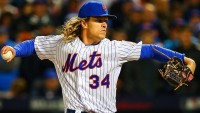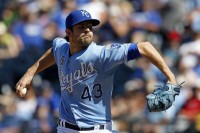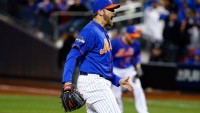So far this season, Terry Collins is using his bullpen heavily. Part of this is his starters do not go as deep into games as they once did. Another factor is Collins is over-managing at times to the point where he is doing matchups when the Mets have large leads late in games. As a result, four of the bullpen arms are on pace for more than 70 appearances in a season with two others not being far behind.
This would not be the first time Collins had a reliever make 70 appearances in a season. In fact, it won’t be the first time he has had multiple relievers make 70 appearances in the season. Can you name all the relievers who have made over 70 appearances in a season? Good luck!
Addison Reed Jeurys Familia Jerry Blevins Carlos Torres Scott Rice LaTroy Hawkins Bobby Parnell Jon Rauch Tim Byrdak
Overall, the tale of Rafael Montero is one of unfulfilled potential. Since at least 2014, the Mets have been tantalized by that potential, and they have given him chance after chance to succeed in the majors. Their reward this year is Montero struggling yet again going 0-2 with a 9.45 ERA, 3.600 WHIP, and a 10.8 BB/9.
In his wake, Montero has left behind a number of Mets pitchers. Some are gone because they were needed to be traded to bulk up the 2015 team to make a postseason run. Others are simply gone because the Mets valued Montero higher than them. The Mets were right in some instances, and wrong in others. Can you name the 32 pitchers who have pitched in the majors since Montero’s call-up in 2014 that are no longer a part of the Mets organization? Good luck!
Gabriel Ynoa Logan Verrett Bartolo Colon Jon Niese Jim Henderson Dario Alvarez Antonio Bastardo Akeel Morris Carlos Torres Buddy Carlyle Eric O’Flaherty Bobby Parnell Tyler Clippard Alex Torres Tim Stauffer Matthew Bowman Jack Leathersich Dillon Gee Michael Fulmer Luis Cessa John Gant Robert Whalen Vic Black Cory Mazzoni Daisuke Matsuzaka Gonzalez German Dana Eveland Jose Valverde Kyle Farnsworth John Lannan
On the dawn of the World Baseball Classic, Mets starter Noah Syndergaard made some waves when he stated, “I’m a Met. Ain’t nobody made it to the Hall of Fame or the World Series playing in the WBC.” (Abby Mastrocco, nj.com).
Judging from attendance at Spring Training, Syndergaard’s belief is not something that is universally shared in the Mets clubhouse. Jose Reyes is one of the few major league players that have appeared in all four WBCs. He is joined on the Dominican Republic team by Mets relievers Hansel Robles and Jeurys Familia.
Fernando Salas threw his first pitch this Spring for Mexico. Brandon Nimmo and Gavin Cecchini have been stars for Italy. Seth Lugo and T.J. Rivera, two players arguably fighting over the last spots on the Opening Day roster, are playing with Mets back-up catcher Rene Rivera for an undefeated Puerto Rico team. Ty Kelly is both fighting for a potential roster spot and for a spot in the semifinal for Israel.
Point is, while Syndergaard doesn’t believe in the importance of the WBC, many of his teammates do. That includes team captain David Wright, who said, “Everybody has their right to their own opinion, and obviously Noah doesn’t think too highly of it. But I do. So I’m not sure if it’s just a different mentality, and I’m not sure if there’s a right or a wrong. But getting a chance to represent your country, and put that jersey on, and hear the chants of ‘U-S-A, U-S-A’ — that’s one of the highlights of my career. (Anthony DiComo, mlb.com).
It should be noted Wright wasn’t calling out Syndergaard like the time he and Bobby Parnell threw Syndergaard’s lunch in the garbage. He wasn’t singling out Syndergaard either noting other great players like Clayton Kershaw have opted not to play in the WBC without having to face the same scrutiny Syndergaard has. Rather, Wright was merely trying to speak to what the WBC has meant to him.
It certainly was one of the highlights of Wright’s career. In the 2009 World Baseball Classic, Wright sent USA to the semifinals with a walk-off hit against Puerto Rico. In the 2013 World Baseball Classic, Wright would loom even larger. He hit the decisive grand slam against Italy that helped propel the United States back to the semifinals. In the 2013 tournament, Wright hit .438/.526/.750 with two doubles, a grand slam, and 10 RBI. Wright was named as the third baseman to the All WBC Team. If not for his intercoastal injury before the semifinals, who knows if USA wins the WBC that year?
Among USA players in WBC history, Wright is second all-time in games played, third in hits, second in doubles, and first in RBI. He is a ,333/.400/.458 hitter in WBC history. He had two huge go-ahead late inning hits that propelled the USA into the semifinals. It is why Wright was dubbed Captain American. Overall, you cannot discuss the greatness of Wright’s career without mentioning the WBC.
It is an event that has mattered to Wright as much as any moment in his career. As Wright said, “Up to this point if you say, ‘Hey, what’s the most fun you’ve had on a baseball field?’ I’d say the World Series. But I would say in the conversation of cool things that I’ve gotten to do on a baseball field, the World Baseball Classic is toward the top of that list for sure.”
Overall, during Spring Training and the WBC, Wright has been noticeably absent. As his health issues continue to linger and keep him off the field, the 2013 WBC and 2015 World Series seem farther and farther away. However, those moments should not serve as the epilogue to a great career for a great Met. Rather, they should serve as highlights.
Deep down, each and every Mets fan must hope Wright has another chapter left in him. It may not happen in the WBC. It may happen in the World Series. And it may just happen this year.
With this Mets team once again built on pitching, the fear continues to be that one of these pitchers will suffer an injury. An even bigger fear is that injury will require Tommy John surgery. This usually means a pitcher is gone for over a year, and as we have seen with Jeremy Hefner and Bobby Parnell, it is not an easy road back, nor is it a guarantee the pitcher will return to form. That is why the route Seth Maness has chosen is so important to the Mets and all of baseball. It creates the possibility that a player can return in-season rather than missing over a year.
Can you name the Mets currently on the 40 man roster who have undergone Tommy John surgery? Good luck!
Jacob deGrom Josh Edgin Chris Flexen Erik Goeddel Matt Harvey Marcos Molina Zack Wheeler
Back in 2013, Mets fans were shocked and depressed when Matt Harvey missed the remainder of the regular season with a torn UCL. Initially, it seemed Harvey did not want the surgery, but eventually he agreed to have the surgery. Fortunately for Harvey, he went through the rehabilitation process with no setbacks, and he became an important part of a 2015 rotation that went all the way to the World Series.
While rehabilitating, he worked alongside former Mets starter Jeremy Hefner. In 2012 and 2013, Hefner had performed better than expected with the Mets, and he finally seemed to carve out some type of a role in the organization. The team even tendered him a contract while he was rehabbing from his own Tommy John surgery. However, disaster struck, and Hefner would need another Tommy John surgery. He would miss all of the 2014 and 2015 seasons. The Mets would non-tender him, and he would have to agree to a minor league contract with the St. Louis Cardinals. Now, with another arm injury, he has since retired.
These are just two of the countless stories we have seen with the Mets when it comes to Tommy John surgery. Recently, we have heard terrific stories about how Jacob deGrom learned how to throw the change-up from Johan Santana while deGrom was rehabiliting from his own Tommy John surgery. It was a great story, and it was something that forever changed the trajectory of deGrom’s career. There have been other Mets who have had their career trajectories change due to the surgery.
At one point in his career, Bobby Parnell was deemed the closer of the future. In 2013, he seemed to take over the role when he recorded 22 saves. In 2014, he would be named the Opening Day closer. It lasted all of one inning as Parnell was shut down and had Tommy John surgery. He tried to come back in 2015, but he did not have the same velocity, and he did not have his command. The Mets showed no interest in re-signing him leading to Parnell signing a minor league deal with the Tigers. After six major league appearances that saw him post a 6.75 ERA, Parnell was released in August.
Of course, the biggest name with the Mets to have issues post-Tommy John surgery was Zack Wheeler. Right before the 2015 season was set to begin, Wheeler was diagnosed with a torn UCL. He would have the surgery, and he would have a number of set-backs. He was initially slated to be a part of the Mets starting rotation around the 2016 All Star break. Instead, he would have a number of setbacks, and eventually, the Mets would shut him down for the season. In total, he threw one inning for St. Lucie in a rehab appearance. Now, the Mets are discussing whether they should move him to the bullpen for at least the start of the season.
Hefner, Parnell, and Wheeler show exactly why the experiment Seth Maness is undergoing is so important to the game of baseball.
For the past four seasons, Maness has been an effective reliever for the St. Louis Cardinals. Because of his own torn UCL, Maness would make his last appearance on August 13th, and it was assumed he would be headed for Tommy John surgery like so many other people have with the same injury. He didn’t.
Derrick Gould of the St. Louis Dispatch reports Maness underwent a surgery called “primary repair” which is ” a repair and buttressing of the existing ligament at the bone, not Tommy John’s reconstruction of the ligament.” Like Tommy John once was, Maness is now a trailblazer that may have the name of a surgery attached to him. The physician that performed the surgery, Dr. George Paletta, spoke about the procedure saying:
In select cases of UCL tears, with this technique, they have the real potential to not miss the next year. This is potentially a huge stride forward in three ways. First, early results show a high success rate. Second, a return to play is cut by 40 percent. That’s a huge factor. We are able to accelerate the return-to-throwing (rehab) program for the athletes. With this technique at the end of 2016 we have a pitcher who is ready to pitch in games by opening day.
And the third way, as a consequence of this, in the right setting, one would feel more confident moving to surgery early on.
Believe it or not, Maness is a week away from being able to take the mound after a little more than seven months after the surgery. It is expected the free agent reliever will be ready to pitch on Opening Day. Once he takes the mound, there is going to be a lot of interest in his performance.
Dr. Jeffrey Dugas, another surgeon who performs this surgery and the managing partner at the Andrews Sports Medicine & Orthopedic Center in Birmingham, AL noted there is now a lot of interest in how Maness performs post-surgery:
People are watching this and it’s an interesting thing for all of us. There is a lot that we need to learn from Seth, a lot that we need to learn from all of the guys (who have had it). We need the data. There are still so many hurdles to go over, but we’re excited to watch what is going to happen because of what is possible. We’re going to follow him very closely.
Therein lies the rub. We had gotten to the point with Tommy John surgery where it had felt almost routine; where we looked at pitchers like Masahiro Tanaka and wondered why he just didn’t get the surgery. The “primary repair” or Seth Maness Surgery is far from that point. However, if Maness has a strong 2017 season, and a couple of more pitcher follow his path, and have similar success stories, the treatment fo UCLs may have been revolutionized.
There may no longer see the Harveys of the world miss more than a season. We may also see an alternative route for the Hefners, Parnells, and Wheelers of the world. Ultimately, when there is at least a chance pitchers will miss less time and have an alternative surgery that may work better for them, it is a time for cautious optimism.
And with that, a middle reliever who induces a number of groundballs could have one of the most important seasons in major league history.
Editor’s Note: this was first published on Mets Merized Online

Going into the 2016 season, there is one fear each and every Mets fan has. We dare not speak its name, but that doesn’t change the fact that it’s still present. That fear is that a pitcher will get seriously injured.
Looking at this year’s list of pitchers who could befall the dreaded “Verducci Effect,” Noah Syndergaard headlines that list. If Syndergaard was to suffer a season ending injury requiring Tommy John surgery? it would greatly hinder the Mets chances of winning not only the World Series, but also making it to the postseason. It’s something that not just Mets fans fear, but as Anthony DiComo of MLB.com reports, Syndergaard fears it also:
I’ve thought about it quite a bit. But I trust myself to put my body in the right situations to be able to perform at a healthy level.
The fear is justified. Syndergaard threw 65.2 innings more last year. He throws over 95 MPH more than anyone in the game. He’s working to add the fabled Warthen Slider to his already dominant repertoire. Name a risk factor for UCL years requiring Tommy John surgery. Syndergaard meets most if not all of them.
One risk factor not readily discussed is the team he plays for. Look at the projected Mets rotation when healthy: Matt Harvey, Jacob deGrom, Noah Syndergaard, Steven Matz, and Zack Wheeler. Put aside Syndergaard for a moment. What do the other four have in common? They are all hard throwing pitchers under the age of 30 who have already had Tommy John surgery.
Go outside this group. Since Warthen took over as the Mets pitching coach, the following homegrown Mets have sustained arm injuries: Jon Niese (shoulder), Dillon Gee (shoulder), Jeremy Hefner (two Tommy John surgeries), Rafael Montero (shoulder), Bobby Parnell (Tommy John), Josh Edgin (Tommy John), Jack Leathersich (Tommy John). There are more, but you get the point.
Now, is this an organizational problem since Warthen took over, or is it just bad luck? Could this all have been avoided? Back in the 60’s and 70’s the Mets developed pitchers like Tom Seaver, Jerry Koosman, Nolan Ryan, and Jon Matlack. These pitchers threw more innings than the pitchers today, and yet, Matlack was the only one of this group that suffered an arm injury.
In the 80’s, the Mets had Dwight Gooden, Ron Darling, Sid Fernandez, Rick Aguilera, Randy Myers and David Cone. Of this group, only Doc and Cone had arm issues. It should be noted that Doc had many other issues as well, and Cone’s problem was an aneurysm later in his career.
In the 90’s, Generation K was a bust, and the Mets haven’t developed the caliber of starting pitchers like they have in the past until now. However, this generation seems to befall injuries far more often than their predecessors. Is it organizational? Is it bad luck? Is it preparation? For his part, Harvey wonders what if:
I think now, there are things I could have done better in high school or in college to maybe prevent it. But I don’t know. I’m not saying [Syndergaard] works that much harder than everybody else, because we all work hard. I think as time progresses, guys pay more attention to stretching the shoulder, strengthening the shoulder. If I could go back — I don’t know if this would’ve prevented me from having [surgery], but if I could go back and really do 20 extra minutes of stretching and arm care, you never know what could happen.
That’s the thing. We really don’t know why one guy suffers elbow and shoulder injuries while others don’t. Is it preparation? Is it good genes? Is it just good luck? Much time, energy, and money has been spent on this issue, and yet pitchers still get injured. Pitchers get injured despite teams doing everything in their power to try to prevent it.
It will help Syndergaard being in a clubhouse with players who have had Tommy John surgery. They each will have advice for him on why they suffered the injury and what they could’ve done differently. More importantly, Syndergaard appears to be a hard worker who takes the health of his arm very seriously. There is no doubt he is doing everything he can do to avoid the dreaded Tommy John surgery.
Based on what we’ve seen, if anyone can avoid it, it’s him.
Editor’s Note: this article was first published on metsmerizedonline.com

Last year, the seminal moment of the Spring was David Wright and Bobby Parnell throwing out Noah Syndergaard’s lunch. This year it was Dominic Smith‘s turn to learn a lesson.
This past weekend, Smith got a hold of one, and he thought it was out. He didn’t flip the bat or admire and pose after hitting it. No, he broke right into his homerun trot. He wasn’t hustling out of the box. When the ball hit the wall, Smith wound up with a single instead of a double.
A ten year veteran might get away with it. Not a AA player. It’s why Terry Collins approached him about the moment. For his part, Smith seemed to get it vowing he would never did it again. He said, “there’s no place for me not to hustle out of the box like that. It’s a learning experience.”
Look, this isn’t about taking fun out of the game. He wasn’t chastised for celebrating a homerun. The manager talked to him about a lack of hustle. It was fair for Collins to do so. Smith is a 20 year old kid with a lot of promise. It’s up to Collins in the little time they have together to help point out to Smith what we needs to do to take the next step.
Hustling out of the box is a fair and legitimate concern. It was never an issue for Smith before, and it probably won’t be in the future. However, Collins took advantage of an opportunity to talk to him. Smith will be a better player for it, which is saying something.
Hopefully, this moment will be Thor’s moment. It will be what we will be talking about one day during his rise to greatness.

If there’s anything that has been a hallmark of these recent Mets teams it’s that these players get it. Win or lose they acknowledged the fans. They even did it in a moment of heartbreak after losing the World Series. I was again reminded of this when I saw Vic Black‘s recent Tweet:
Thank You New York
Read: https://t.co/AS32hnPqBu
— Victor Black II (@Vic_Black_2) February 2, 2016
In the TwitLonger link, Vic Black acknowledged his New York Mets career was over even if he hasn’t signed with anyone else. He then went on to thank Mets fans for cheering him during his all too short stay with the Mets:
You were kind in welcoming me to YOUR family and I’ll always have blue and orange running in my blood. New York captured my heart and nothing can ever take that away. You gave me a gift, experiences and moments I’ll cherish forever. I’m counting the days till my next visit in whatever capacity that may be. I love you New York!
At first glance, this made me smile. Black was something of a fan favorite. Poor Adam Rubin was inundated with requests for updates on his status. It’s great Mets fans had an impact upon him. It’s even better that he acknowledged our love and returned the love.
It’s funny that it didn’t always start out that way. Black was acquired in the Marlon Byrd trade. At that time, Byrd was something of a fan favorite himself, and he was being traded for a second base prospect, Dilson Herrera, and a live bullpen arm in Black. A lot of the qualms with that trade went away when Black began pitching with the Mets.
In his two years with the Mets, Black was a good and improving reliever. In his 56 appearances, he had a 2.83 ERA, 125 ERA+, 3.65 FIP, 1.259 WHIP, and an 8.3 K/9. He had a blazing 97 MPH fastball. Unfortunately, he would have a neck injury in 2015, suffer a setback in April, and he would never be recalled to the majors. He was unceremoniously removed from the 40 man roster and made a minor league free agent. It didn’t matter that Black regained his fastball. It didn’t matter that he has been a good reliever who is still just 27.
Apparently, Black wants to be back, and Mets fans want him back. Personally, I want him to return, even if it appears he won’t. Whenever he lands, that team is getting a good reliever and an even better person. When he comes back to New York and he comes running out of the bullpen, I’ll be cheering for him.
Good luck Vic Black.

When perusing the list of players who were non-tendered, I noticed Aaron Crow. He’s a talented reliever, who the Mets should pursue.
Crow was non-tendered by the Marlins after missing the 2015 season due to Tommy John surgery. He was a former first round pick by the Royals, who failed as a starter, so they converted him into a reliever.
In his first year as a reliever, he was an All Star. For his career, he has an ERA+ of 120, a 4.16 FIP, and an 8.0 K/9. In terms of more traditional stats, he’s 20-11 with a 3.43 ERA and a 1.322 WHIP. For his career, batters have hit .243/.321/.382. He fared better against righties (.229/.310/.327) than lefties (.262/.336/.455). Much of these career stats are skewed by an awful 2014, which was his last year before needing Tommy John surgery.
After seeing Bobby Parnell struggle last year post-Tommy John, Crow shouldn’t received more than a minor league deal. (Quick aside, the Mets should bring back Parnell on a minor league deal as well). He probably won’t receive more than that with his availability to start the year being a question mark. However, he’s well worth the flyer as he had a fastball that traveled between 93-97 MPH when healthy.
For a team rumored to be seeking bullpen help, brining on Aaron Crow is a no-brainer.
